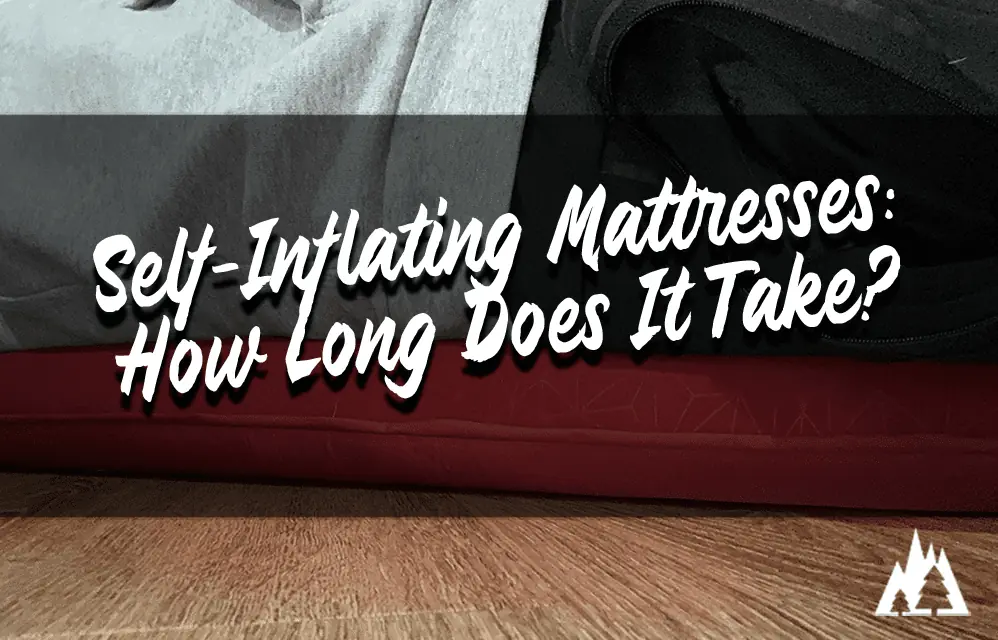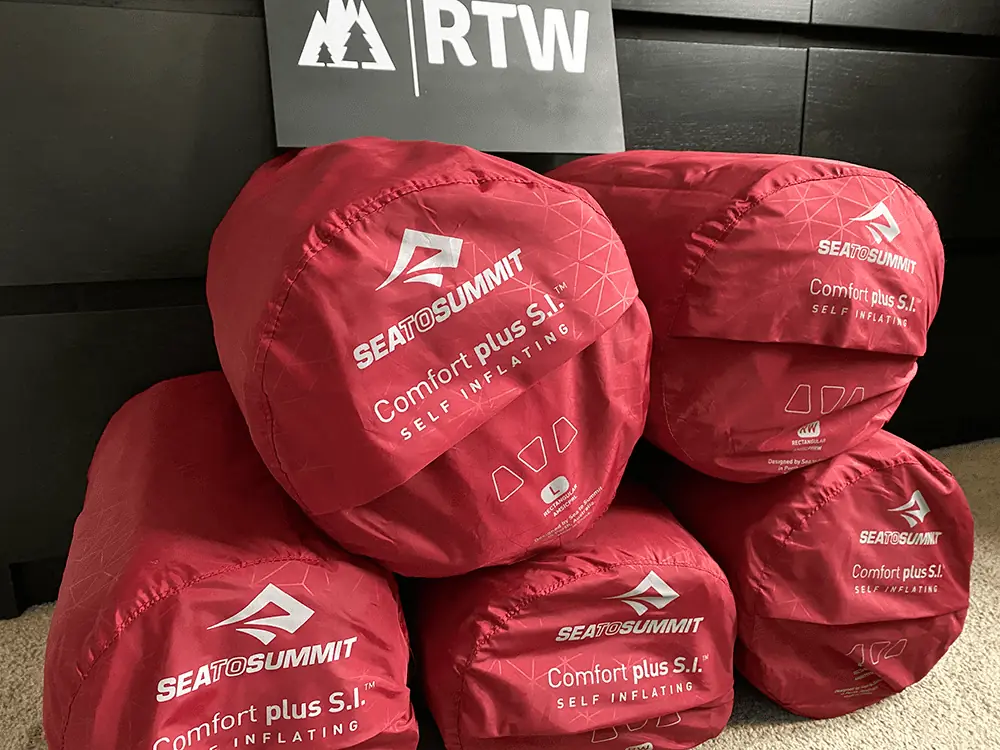How Long Does a Self-Inflating Mattress Take to Inflate?

When you pack a ton of stuff as I do for camping, any time saved is more time to relax.
Especially when you’re hauling camping equipment and gear for a family of 5 like mine.
Over the years, I’ve fine-tuned my list of camping gear to fulfill 3 main things:
- Faster setup (instant tents, Jetboil, all that good stuff)
- Space saving (chairs, mattresses, etc.)
- Survival (knives, GPS, etc.)
And self-inflating mattresses are a perfect choice for people like me.
But how long does a self-inflating mattress take to inflate?
Self-inflating mattresses normally take a few hours to self-inflate when it’s brand new. I suggest even letting it sit overnight because it’s probably been rolled up by the manufacturer for months or years.
Don’t think you’ve got a defect. The first time will be the longest.
After the first time, from my experience, it can take anywhere from 20 – 30 minutes for it to self-inflate enough for me to manually pump a little air for my desired firmness.
The amount of time it takes to inflate depends on several factors, such as:
- Size and type of mattress
- Temperature outside
- How much air is already in the mattress before inflating
Factors That Affect Inflation Time
Do you have a single mattress or a double-wide mattress?
The size and type of mattress are two major factors that affect inflation time.
A larger or thicker mattress will take longer to inflate than a smaller one.
Also, some mattresses use different foam types, affecting inflation times.
For example, open-cell foam mattresses tend to take longer than closed-cell foam mattresses because they require more air pressure for proper inflation.
As mentioned, if your mattress has been rolled up for an extended period before you begin inflating, it may take longer due to trapped air inside the material that needs to escape before additional air can enter.
Don’t worry – it’s not a defect.
Average Inflation Times
On average, most self-inflating mattresses should fully inflate within 20 – 30 minutes, depending on the conditions mentioned above.
If camping in cold weather, expect slightly slower inflation times since colder temperatures reduce air pressure, making it harder for the valve mechanism to quickly push out enough air into the chamber for full inflation.
What is a Self Inflating Mattress?
A self-inflating mattress is an inflatable sleeping pad made from lightweight material with air pockets that expand. It can be inflated manually by blowing into the valve or automatically using a pump. When deflated, it rolls up tightly for easy storage and transport.
You’re basically allowing air to fill back into the foam that the mattress is made of.
Imagine a dry sponge ball, and you close it tight inside your fist.
Once you open your hand, the sponge will return to its natural form. So that’s essentially what you’re doing here.

There seems to be a misconception about self-inflating mattresses, or how people picture them at least, that they think they can throw it in the air and poof.
You have a fully inflated mattress to sleep in seconds.
That’s not the case.
I got them to let it self-inflate inside my tent while I’m working on setting up camp, I come back later and add a few more pumps of air, and I’m done.
It saves me time and is extremely comfortable for my family and me.
The materials used in these mattresses vary depending on the manufacturer but typically include a combination of polyester or nylon fabric, foam padding, and airtight plastic valves.
Materials Used
Self-inflating mattresses are usually constructed from durable fabrics such as nylon or polyester, resistant to tears and punctures. Inside the fabric layers is an open-cell foam core that provides cushioning for your body while you sleep and insulation against cold temperatures outside your tent or shelter.
Finally, two types of valves are used; twist locks (for manual inflation) and push/pull valves (for automatic inflation).
Benefits of Using a Self-Inflating Mattress
The main benefit of using a self-inflating mattress is its convenience.
They offer great insulation against cold ground temperatures, so you stay warm throughout the night without having to layer multiple blankets on top of each other, as traditional camping beds require.
They also pack down small enough to easily fit into any backpack, making them ideal for backpacking trips with limited space.
How to Inflate When You First Purchase It?
Setting up a self-inflating mattress for the first time is simple. With just a few steps and some troubleshooting tips, you’ll be ready to hit the trails with your new sleeping pad.
To get started:
- Unroll your mattress and locate the valve at one end of the pad
- Open this valve by twisting it counterclockwise until it is fully open (you should hear air coming out).
- Close off both valves securely once satisfied with how much air has been added to each side.
How to Increase Firmness?
Self-inflating mattresses come with a valve that allows you to adjust the firmness of your mattress. To increase firmness, turn the valve clockwise until it is fully closed. This will prevent air from escaping and make your mattress firmer. If you want even more firmness, you can add extra air by blowing into the valve or using an air pump.
Alternatively, if you don’t have access to a pump, you can manually blow into the valve yourself until it is full enough for your needs. Once done inflating, close off the valve again so that no more air escapes from inside of it.
Features to Look for When Buying?
When shopping for a self-inflating mattress, size and weight considerations are important.
Heck, shopping for one you like is harder than inflating them. Ha
If you plan to take your mattress on camping trips or hikes, it is important to consider the size of the mattress when folded up and its total weight.

I used to own two Exped self-inflating mattresses.
I loved them. They were comfortable and well-made.
The only downside to them is they don’t really pack down well.

But as our family grew, I had to downsize to smaller, but still very functional, Sea to Summit brand mattresses, and they’re great. (Review coming shortly)
They are thinner and smaller than the Exped, but I had no issues feeling the ground when camping.
A larger mattress is more comfortable but may not easily fit in your backpack or car. It is also important to look at how much air capacity the mattress has, as this will affect how firm it can get when inflated.
Durability features should also be considered when selecting a self-inflating mattress.
Look for mattresses with reinforced seams and heavy-duty fabrics designed to withstand wear and tear from regular use. Check if there are any warranties available with the product so you know what kind of protection you have if something goes wrong with your purchase.
Comfort features should be considered when choosing a self-inflating mattress.
Many mattresses come with adjustable valves, so you can adjust the air inside for more support or less, depending on personal preference. For example, some mattresses even have built-in pillows, which provide extra cushioning while sleeping outdoors.
Some mattresses offer insulation layers that help keep warm air during cold nights outside under the stars.
Other things I look for that are often overlooked are grips on the bottom side, so it doesn’t slide, and ease of rolling the mattress back into the sack.
Care and Maintenance of Self Inflating Mattresses
Caring for your self-inflating mattress is essential to ensure that it remains comfortable and lasts for years.
Proper maintenance will also help you get the most out of your investment. Here are some tips on how to care for and maintain your self-inflating mattress:
Cleaning and Storing Your Mattress
Before storing, clean off any dirt or debris from the surface of the mattress with a damp cloth or sponge. Once cleaned, store in a cool, dry place away from direct sunlight or extreme temperatures.
Make sure not to fold or bend the mattress near the valves when storing it, as this can damage its internal components.
Repairing Damaged Valves or Seams
If you notice any tears in the seams of your self-inflating mattress, use an adhesive patch kit designed specifically for repairing air mattresses (available at most outdoor stores).
If there’s an issue with one of the valves, try replacing it before attempting repairs, as they are usually easy to replace and inexpensive too.
Replacing Parts as Needed
Over time parts may need replacing due to wear and tear, such as valve caps, O-rings, plugs, etc., so make sure you have replacements handy.
It’s also important to check all connections regularly for signs of leaks which can be easily fixed by tightening them up again using pliers if necessary.
Taking proper care of your self-inflating mattress will ensure comfort during camping trips year after year.
Regularly cleaning and checking parts like valves and seams can help prevent issues in the future while ensuring maximum performance from your investment over time.
FAQs
How do you inflate a self-inflating air mattress?
Inflating a self-inflating air mattress is relatively easy:
1. Unroll the mattress and remove any packaging materials.
2. Open the valve on one end of the mattress and allow it to inflate for several minutes until it reaches your desired firmness. If you want an even firmer surface, use a hand or electric pump to add additional air pressure to the mattress.
3. Close the valve tightly when finished inflating to prevent air from escaping, and enjoy your comfortable sleeping surface.
How does the self-inflating mattress work?
Self-inflating mattresses are designed to provide comfort and support while camping.
They use an open-cell foam core surrounded by a waterproof, airtight fabric.
When the valve on the mattress is opened, air rushes in and expands the foam core, inflating it automatically.
The user can then adjust the firmness of the mattress by adding or releasing more air as needed. Once deflated, self-inflating mattresses can be rolled up for easy storage and transport.
They offer great insulation from cold ground temperatures and provide comfortable cushioning for a good night’s sleep outdoors.
How do self-inflating sleeping pads inflate?
Self-inflating sleeping pads are designed to inflate on their own with the help of a built-in foam core. When you open the valve, the air is drawn into the pad and inflates the foam core.
The process usually takes about 20 – 30 minutes and can be sped manually by blowing air into it. Once fully inflated, these pads provide comfort and insulation from cold ground temperatures while camping or backpacking.
They are lightweight and easy to transport, making them an ideal choice for outdoor enthusiasts looking for a good night’s sleep.
Before You Go
Before you go, I highly recommend you check out these resources for getting a better sleep out in the wilderness:






